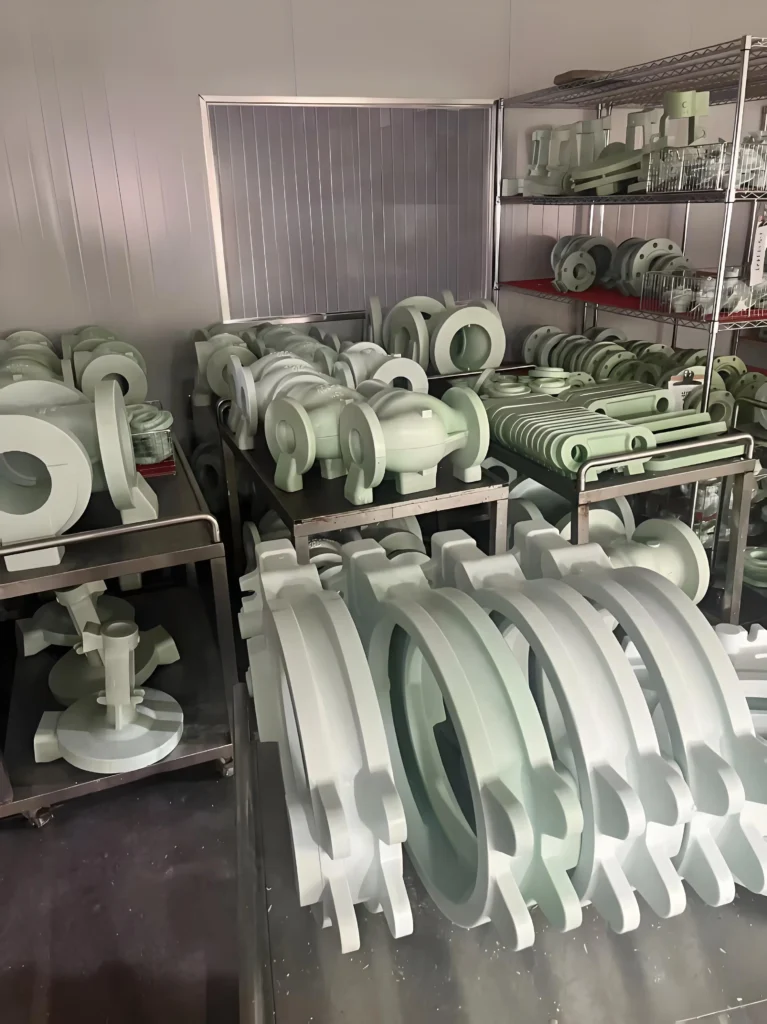Lost foam casting is a new casting method that combines paraffin or foam models with similar size and shape to the casting into a model cluster, brushes refractory paint and dries it, buries it in dry quartz sand for vibration molding, pours it under negative pressure, vaporizes the model, and the liquid metal occupies the position of the model. After solidification and cooling, it forms a casting.
Features:
High casting accuracy: Lost foam casting is a new process with nearly zero allowance and precise molding. The casting has no flash, burrs and draft angle, high dimensional accuracy and low surface roughness.
High surface finish: Due to the process characteristics of lost foam casting, the surface of the casting is smooth. High degree, reducing the subsequent cleaning and polishing workload
Simplified production process: Lost foam casting cancels the sand mold and core making department, greatly simplifies the molding process, and eliminates casting defects and waste caused by mold removal and box assembly
Reduced material consumption: Adopting dry sand molding without binder, moisture, and any additives, eradicates various casting defects and waste caused by moisture, additives and binders, and the molding sand can be reused
Environmentally friendly: Lost foam casting can achieve large-scale and mass production, suitable for manual operation and automated assembly line production operation control. At the same time, because the sand box is negatively pressurized during pouring, the gasified gas is easy to extract, solve and discharge in a centralized manner, which greatly improves the working environment, reduces labor intensity, and reduces energy consumption
The technical details of lost foam casting mainly include gating system design, model making and coating, pouring operation and negative pressure control.
Gating system design
The design of the gating system needs to take into account the influence of the existence of the model cluster on the behavior of the molten metal after pouring. Due to the presence of the model, the molten metal will encounter additional resistance during pouring, so the cross-sectional dimensions of each part of the pouring system should be slightly larger than that of sand casting to ensure that the molten metal can smoothly fill the mold cavity. At the same time, the design of the pouring system also needs to be calculated in a targeted manner based on factors such as the size of the casting, the combination of the model clusters, and the number of pieces per box. Model making and coating application The models of lost foam casting are usually made of materials such as paraffin or foam plastics, which need to be bonded and combined into model clusters. During the production process, the quality of the model must be ensured to avoid adverse effects on the dimensional accuracy and surface finish of the casting. After the model is made, it is necessary to apply refractory coating and dry it to enhance the adhesion between the model and the outer surface of the pouring system and improve the refractory performance of the model. The choice of coating and coating process have an important influence on the quality of the casting, and need to be selected according to factors such as the size and shape of the casting. Casting operation The pouring operation of lost foam casting needs to be kept stable to avoid cold shut defects caused by intermittent pouring. During the pouring process, the liquid level in the pouring cup should be kept stable to keep the pouring dynamic pressure head stable. At the same time, the pouring temperature needs to be controlled, which is generally slightly higher than that of sand casting to meet the heat required for model gasification. Too high a pouring temperature may cause defects such as sand sticking to the casting, while too low a pouring temperature may cause defects such as insufficient pouring and cold shut in the casting.
Negative pressure control
Negative pressure is one of the important parameters in the lost foam casting process. The role of negative pressure includes increasing the strength and rigidity of the sand mold and removing the gasification products of the model. During the pouring and solidification process, the casting mold needs to maintain a constant negative pressure state to ensure that the casting surface is smooth, the size is accurate and there is no flash. The selection of negative pressure value needs to be determined according to factors such as the material and size of the casting, and it should be selected and adjusted before pouring.
Lost foam casting is used in the production of special-shaped castings and various casting processes.
As an advanced casting process, lost foam casting has shown great advantages in the production of special-shaped castings. It can greatly simplify the production process and improve production efficiency, while effectively avoiding problems such as seams and misalignment in castings, and significantly improving the appearance quality of castings. Whether it is large-scale or single-piece small-batch castings, lost foam casting can produce efficiently. In addition, lost foam casting coatings are also suitable for a variety of casting processes, such as investment casting, resin sand casting and metal mold casting, which further broadens the application field of lost foam casting.
Common problems and solutions of lost foam casting mainly include sand inclusion defects, slag inclusion defects, local mold collapse, mold hotness, looseness, inclusions and box collapse, etc.
Sand inclusion defect: Sand inclusion caused by loose sand on the surface of the pouring cup, inappropriate shape of the pouring cup, thin coating layer of the sprue, etc.
Solution: Ensure that the surface of the pouring cup is tight and free of loose sand, select the appropriate shape of the pouring cup, increase the thickness of the coating layer of the sprue, and improve the bonding process to ensure the high temperature resistance of the paper tape
Slag inclusion defect: The ladle is not completely slaged before pouring, or slag continues to be produced during the pouring process
Solution: Thoroughly slag before pouring to ensure that there are no impurities in the ladle, and strengthen the slag removal operation during the pouring process
Partial mold collapse:The sand filling at the concave corner is not solid, and a cavity is formed under the action of negative pressure, which destroys the coating layer when the molten iron is filled
Solution: Change the buried box angle to ensure the filling effect; use resin sand and other local filling to ensure the dry sand filling effect; use manual auxiliary sand filling when necessary
Hot mold: Too much residual sand in the sand box, too high sand temperature in the buried box, and too close distance between the molds cause hot molds Mold phenomenon
Solution: Level the hot sand remaining in the sand box, spread the buried sand and maintain a certain thickness; detect the sand temperature to avoid it being too high; control the swing mold distance to prevent the high temperature of the molten iron from damaging the white film
Looseness: Looseness caused by unclean degassing of the alloy liquid, insufficient shrinkage compensation at the solidification site, local overheating of the casting mold, etc., Solution: Maintain a reasonable solidification sequence and shrinkage compensation; keep the charge clean; place cold iron in the loose part; perform repair welding at the part where repair welding is allowed
Inclusion: Inclusion caused by foreign matter mixed into the liquid alloy, poor refining effect, and foreign matter peeling off the surface of the inner cavity of the casting mold
Solution: Carefully refine and pay attention to slag removal; the coating layer of the smelting tool should be firmly attached; the pouring system and the cavity should be cleaned; the charge is kept clean; the surface inclusions can be polished and removed, and repair welding is performed when necessary
Box collapse: Box collapse caused by unreasonable distribution of negative pressure field, premature pressure relief, slow pouring time, etc. 2. Solution: Rationally distribute the negative pressure field, and use pipelines to introduce negative pressure into the inner cavity of the yellow mold when necessary; specify the pressure relief time to avoid premature pressure relief; meet the time requirements of the process during pouring
Lost foam casting market prospects
Lost foam casting technology continues to innovate and develop, adapting to the needs of modern manufacturing for high efficiency, energy saving, and environmental protection. Its production line is compact and highly automated, which is very suitable for mass production of a single product. The process control is relatively simple, which significantly improves production efficiency and quality. In addition, lost foam casting also has the advantages of energy saving and environmental protection, which is in line with the current development trend of green environmental protection and is expected to gain broader development space with the support of national policies.

Lost foam mold/pattern





